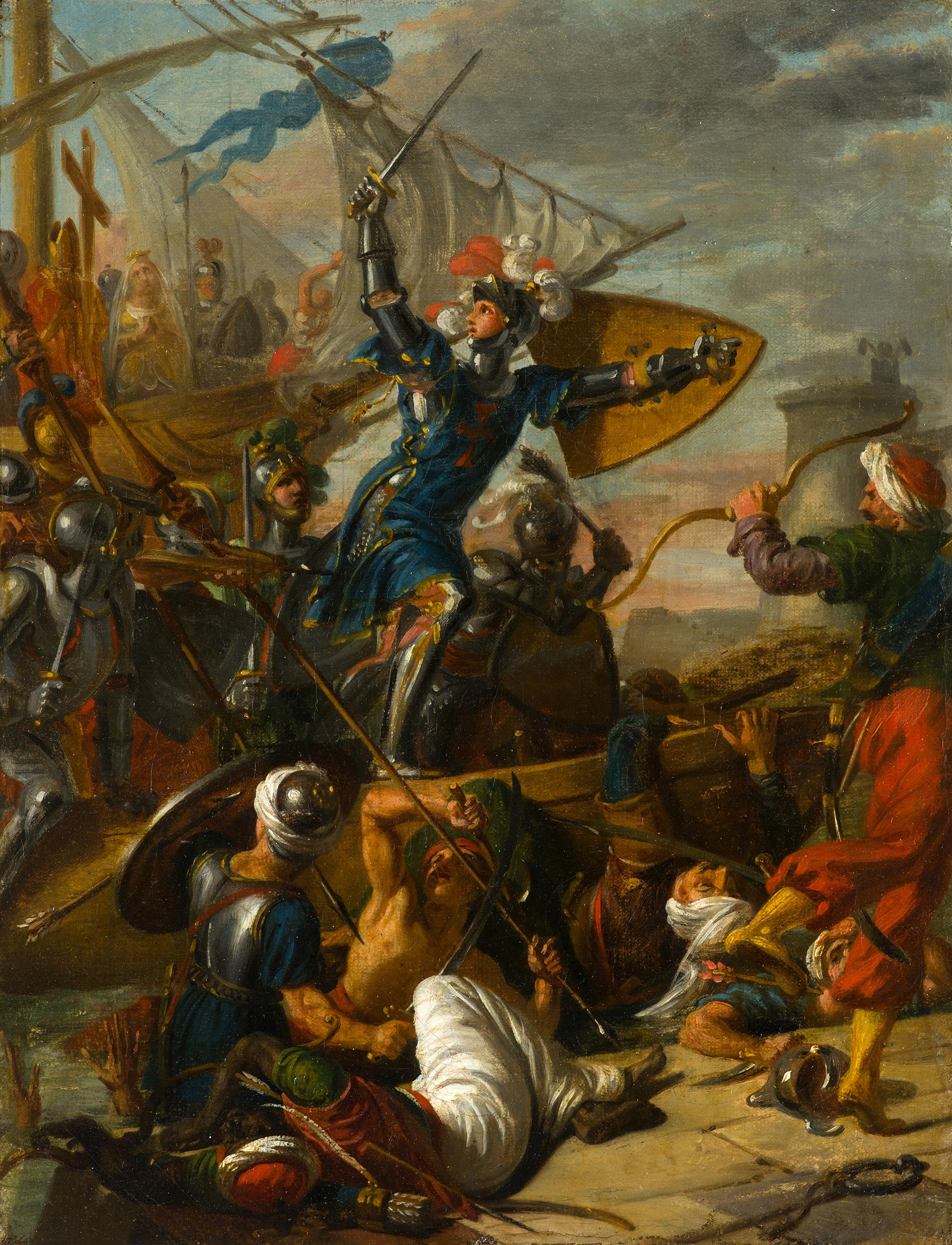
Tardieu
Jean-Charles, dit Tardieu-Cochin
Saint Louis at the Battle of Damiette
Oil on canvas.
32,2 x 24,3 cm (12 11/16 x 9 9/16 in.)
Born into a dynasty of engravers, Jean-Charles Tardieu was the son of Jacques Nicolas Tardieu and the grandson of Nicolas-Henri Tardieu, both academicians and engravers to the King; his mother, Claire Tournay, and his paternal grandmother, Marie-Anne Horthemels, were also engravers. Jean-Charles Tardieu naturally learned engraving and became a pupil of Charles Nicolas Cochin, whose name he sometimes added to his own. But an apprenticeship in the studio of the painter Jean-Baptiste Regnault, from 1786 to 1789, led him away from this profession and towards history painting. Failing to win the Académie’s first prize in 1790, Tardieu had to settle for second prize, which did not prevent him from pursuing an honorable and fruitful career as a history painter. He debuted at the Salon in 1793 and took part in eight exhibitions at the Louvre between 1806 and 1822. Benefiting from his undeniable talent and important family connections, Tardieu quickly won numerous official commissions, firstly under the Empire with, for example, L’Empereur Napoléon reçoit la reine de Prusse (Emperor Napoleon receiving the Queen of Prussia, Salon of 1808) and L’Empereur remettant une pension de cent napoléons à Nerocki âgé de 117 ans (The Emperor giving a pension of one hundred napoleons to Nerocki, aged 117, Salon of 1812), both in the Château of Versailles and of Trianon. His success continued under the Restoration, and he kept on working for Louis XVIII and Charles X, with allegories such as Clio inspire par le buste de Louis XVIII (Clio inspired by the bust of Louis XVIII, Paris, Louvre museum) and L’ Allégorie de la naissance d’Henri d’Artois, duc de Bordeaux (Allegory of the birth of Henri d’Artois, Duke of Bordeaux, Rouen, museum of Fine Art).
This beautiful, lively sketch is a preparatory work for an oil on canvas in the chapel of the former Récollets convent, known as the Chapelle des Récollets (Privas, Auvergne-Rhône- Alpes). The painting, produced in 1822, celebrates one of the military episodes of the Seventh Crusade, led from 1248 to 1249, the capture of the city of Damietta (Egypt) by Louis IX and his men against the ailing Sultan of Egypt Malik al-Salih Ayyoub.
In the background, inside the ship, Marguerite de Provence is shown with her hands clasped in prayer. The Queen, who had followed him on the Seventh Crusade, during which she gave birth to their three children, skillfully negotiated the king’s release from captivity in 1250.
The sketch is very close to the painted work, apart from a few minor differences, such as a helmet rolling on the ground, the buildings in the background, and the color of the flag flying over the ship in the background. At the beginning of the 19th century, with his lively brushstrokes, the painter continued the academic tradition of history painting, no longer depicting the great events of ancient history, but rather the great moments of national history, which had become fashionable from 1770-1780 enjoyed a spectacular revival after the French Revolution.
Extensive research by Gérald Lefebvre has made it possible to place this historical composition within a larger ensemble of five large historical compositions and two allegories made for « the apartments of SAR Monsieur in Fontainebleau », according to a handwritten note by Tardieu’s widow, who inventoried the works of her husband acquired by the various ministries. The ensemble was in fact intended to be woven by the Gobelins factory. Indeed, a quote dated 11 July 1820 drawn up by the Intendance du Garde Meuble de la Couronne mentions an expense for the production of « paintings to be used to make cartoons for the Gobelins hangings intended for the Salon of the flat of HRH Monsieur at Fontainebleau ». This was to decorate the salon in the flats of the Comte d’Artois, the future Charles X. The quote details the subjects:
- Saint Louis rendering justice under an oak tree in Vincennes:formerly in the collections of the Louvre (INV 8096), the painting was deposited with the Mathon-Durand municipal museum in Neufchâtel-en-Bray but now appears to have been lost.
- Saint Louis at Damietta rushing to the shore against the Saracens and setting an example to his troops: the painting corresponding to this subject and to our sketch is dated 1822; it is kept in the chapel of the Récollets, in Privas.
- Saint Louis washing the feet of the poor on Maundy Thursday: the painting, belonging to the Louvre (INV 8097), is on deposit at the church of Notre-Dame d’Orbec, in Orbec.
- At the Battle of Ivry, Henri IV, after giving orders to his generals, shows them his white plume as a rallying point and adds these memorable words: « You will always find him in the path of glory and honour ». The painting, dated 1824, belongs to the Louvre (INV 8101) and is on deposit at the Château de Pau museum.
- During the siege of Paris, Henri IV allowed supplies into the city and distributed relief to the inhabitants who took refuge in his camp: the painting belongs to the Louvre (INV 8102) and is kept at the Musée national des châteaux de Versailles et de Trianon.
- Allegorical figures and symbols representing the virtues of the Bourbon dynasty: Prudence and strength; generosity and kindness. The works, for which two modelli survive in a private collection, were identified at the Musée de Valence by Gérald Lefebvre.
The paintings were handed over to the royal administration by Tardieu on 21 July 1824 at a price of 4,500 francs each. In the end, according to Fernand Calmette, only the allegories were woven, listed as Truth and Abundance (which does not seem to correspond exactly to the description in the estimate, the modelli and the paintings in Valence), but the tapestries disappeared in the fire at the Gobelins in 1871. Still according to Calmette, the historical paintings as a whole were considered too weak. Only Saint Louis débarquant à Damiette was presented to the commission of inspectors and the heads of workshops at the Manufacture des Gobelins. The composition was deemed unsuitable for tapestry and the rest was not made. Above all, it seems that on the death of Louis XVIII, having lost his protectors in the royal administration, Tardieu ceased for a time to receive the support and favours he had enjoyed until then.
The modelli appear to have remained together until they were sold at auction relatively recently. Perhaps they remained in Tardieu’s studio: they are not explicitly listed in the painter’s post-death inventory, but may have been listed under the lot « eight sketches painted in oil representing various subjects and compositions fetched the sum of twenty-four francs ».
The discovery of these modelli makes it possible to revisit what could have been one of the great decorative and historicist commissions of the Restoration, following the example of the series woven between 1820 and 1827 from compositions by Georges Rouget and intended to decorate the throne room of the Tuileries palace, which was also poorly received and finally installed in the Salon François Ier of the Château de Fontainebleau under Louis-Philippe.

